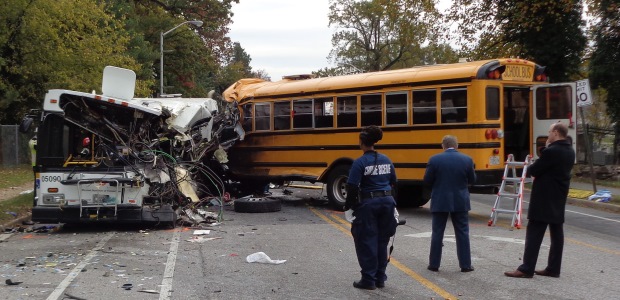
School Bus Driver in Maryland Crash Unauthorized to Operate Commercial Vehicle: NTSB
Because a medical certificate was not on file, the Maryland Motor Vehicle Administration notified the school bus driver about two months before the Nov. 1 crash that he was no longer authorized to operate a commercial motor vehicle, NTSB reported.
The National Transportation Safety Board's preliminary report about the Nov. 1, 2016, crash in Baltimore of a school bus, a car, and a transit bus indicates the school bus driver had a history of hypertension, diabetes, and seizures and had been involved in at least 12 crashes or incidents during the previous five years while operating a school bus or personal vehicle. "Reports from a number of these cases described seizure-like episodes. At the time of the crash, the school bus driver held a current medical certificate, but it was not on file with the Maryland Motor Vehicle Administration. Because the medical certificate was not on file, the Maryland Motor Vehicle Administration notified the school bus driver about two months before the crash that he was no longer authorized to operate a commercial motor vehicle," NTSB reported.
The school bus was contracted for Baltimore City Schools; it struck a Ford Mustang and then a Maryland Transit Administration bus. The school bus was occupied by a driver and an adult teacher aide, the transit bus by a driver and 13 passengers. The drivers of both buses and four transit bus passengers were killed, while seven other passengers were seriously injured. The teacher aide and two transit bus passengers sustained minor injuries, as did the driver of the car.
NTSB said its preliminary report indicates the school bus was traveling approximately 57 mph just before striking the Mustang, and the car's airbag control module recorded that it was traveling approximately 16 mph when it was struck from behind. "After colliding with the Ford Mustang, the school bus continued more than 800 feet and was traveling about 45 mph before impacting the MTA bus, which was traveling about 39 mph. The posted speed limit in the area was 30 mph," according to NTSB, which said preliminary information suggests neither bus driver was using a cell phone at the time of the crash, and they were not operating beyond hours-of-service regulations. Mechanical inspections found no mechanical defects with either bus.
The crash remains under investigation by the Baltimore Police Department and NTSB.